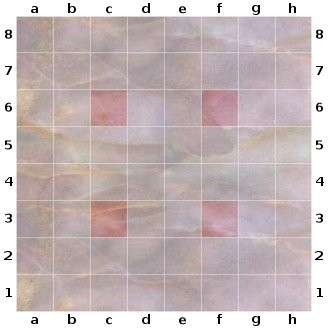Arimaa/Introduction to Strategy/Early Ideas
< Arimaa < Introduction to StrategyDirect Goal Is Impossible

| |||||||||||||||||||||||||||||||||||||||||||||||||||||||||||||||||||||||||
| Gold has no way to make progress with the h6 rabbit | |||||||||||||||||||||||||||||||||||||||||||||||||||||||||||||||||||||||||
The most straightforward strategy in Arimaa is to advance a rabbit and some strong pieces, attempting to rip a hole in the opponent's defenses through which the rabbit can score a goal. If both players try to do this, the game turns into a race. Each player in a race must judge how many steps to spend delaying the opposing rabbit, and how many steps to use furthering their own rabbit.
Before long, however, the Arimaa community discovered that if one player tries to force goal in the opening while the other player defends, advantage accrues to the defender. The board is too crowded for rabbits to make headway until some defenders have been captured, but the defender can easily protect his troops from capture while they are all still at home. Meanwhile the attacking rabbit is vulnerable to capture in the defender's home traps. In the diagram at right, the h6-rabbit is no threat to reach the goal, but the rabbit itself is in danger of capture in f6. Furthermore, rabbits can't retreat, so the h6-rabbit can't save itself. Finally, if the gold elephant advances to g6 to protect the h6-rabbit, the elephant will be blockaded.
Two threats

| |||||||||||||||||||||||||||||||||||||||||||||||||||||||||||||||||||||||||
| Gold has two threats and will win material | |||||||||||||||||||||||||||||||||||||||||||||||||||||||||||||||||||||||||
In light of the futility of forcing an early goal, top Arimaa players next turned to capturing pieces as the most plausible strategy. The main offensive strategy was to drag an opposing piece to one's own home traps for capture. (An elephant can safely go hunting for a piece to pull home, because elephants aren't vulnerable to capture.) Suppose Gold threatens a silver piece with capture in a home trap. The silver elephant can camp out by that trap, and Gold can never capture anything there: the elephant defends other silver pieces, and can't itself be pushed or pulled. In order to make progress, Gold must make two (or more) simultaneous threats in different parts of the board so that the silver elephant can't cover them all. These might be direct capture or goal threats, or threats to secure some positional advantage.
Hostages and frames are two ways to obtain a long-term capture threat. While holding a hostage or frame, Gold can seek a second threat elsewhere on the board. In the best case, such a position will tie the silver elephant to defense, and give Gold the strongest free piece elsewhere.
In the diagram at right, the horse frame in c3 makes the gold elephant the strongest free piece. Using this advantage, Gold has managed to take over the f6 trap. Faced with two threats, Silver has no way to avoid material loss.
Defensive stalemate?

| |||||||||||||||||||||||||||||||||||||||||||||||||||||||||||||||||||||||||
| Silver has defended against an elephant with an elephant, and against a camel with a camel | |||||||||||||||||||||||||||||||||||||||||||||||||||||||||||||||||||||||||
In the early days of arimaa, some players feared that the game was by nature too defensive for attacking play to ever pay off. Consider: at left, Gold has made a threat with his elephant (blocked by the silver elephant) and a threat with his camel (blocked by the silver camel). Gold is apparently stymied despite having generated a capture threat in each home trap. Indeed, one might wonder why pieces of equal strength don't stalemate each other on down the line, resulting in a quagmire where neither side can ever make progress. However, such positions tend to be unstable: the gold elephant can switch wings to chase the silver camel. This may result in a camel hostage, the first deep strategy ever discovered in arimaa, which would give Gold the strongest free piece.
A note on the functions of pieces
In arimaa, the strength and function of a piece depends on what pieces remain on the board. For instance, if each side has lost a camel and a horse, the remaining horses are the unique second strongest pieces on each side, and so have essentially the role that the camels had initially. When the following sections discuss strategic features such as camel hostages, it should be borne in mind that the actual pieces involved may differ if exchanges have taken place.